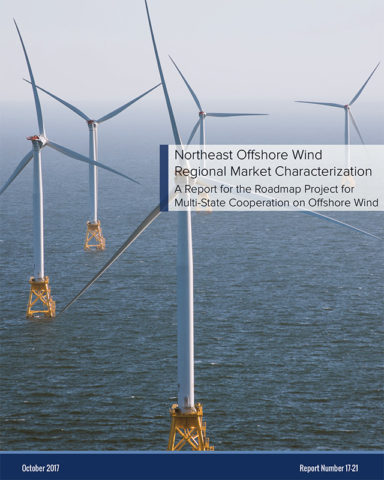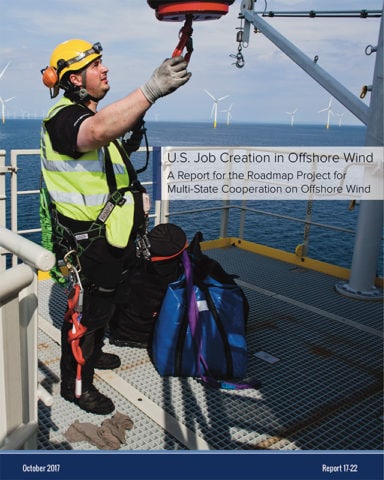Project Menu
Northeast Wind Resource Center - A Roadmap for Multi-State Cooperation on Offshore Wind Development
In 2016 and 2017, CESA coordinated a regional offshore wind roadmap project with Massachusetts, New York, and Rhode Island. The participating agencies in this collaborative project were the Massachusetts Clean Energy Center, the Massachusetts Department of Energy Resources, the New York State Energy Research and Development Authority (NYSERDA), and the Rhode Island Office of Energy Resources. CESA played a coordinating role.
In 2015, the U.S. Department of Energy awarded a grant of $592,000 to NYSERDA for the project. The grant period ran from January 1, 2016 through December 31, 2016.
This webpage provides general information about the Roadmap project. Reports and webinars from the Roadmap project are archived here.
PROJECT DESCRIPTION
In 2015, several states in the Northeast decided to explore the potential for mutual action to develop offshore wind at the scale necessary to reduce costs by achieving economies of scale and establishing a regional supply chain. The states agreed to work together to develop a series of analytical reports and a regional roadmap to identify each state’s individual objectives and the objectives of the region to scope out a near-term and long-term pipeline of projects using several possible penetration scenarios. The final product of the project will be an internal Regional Roadmap for follow-up action.
THREE ANALYTICAL REPORTS
The participating states commissioned a series of analytical work products. Three reports were released publicly on November 2, 2017.
Northeast Offshore Wind Regional Market Characterization
This report, produced by a team led by Sustainable Energy Advantage, described the context for offshore wind deployment in the region. It answered the question: What could the scale of offshore wind deployment be in the region, given the nature of the offshore wind resources, individual state policy drivers, energy needs, and existing electricity generation and transmission capacity? It estimated the upper and lower bounds of the market for offshore wind between 2017 and 2030 in megawatts installed and annual megawatt hours produced. This report was important for ensuring that the states all had a common body of knowledge about offshore wind in the region and for understanding the potential scale of the region’s project pipeline through 2030.
U.S. Job Creation in Offshore Wind
A study by BVG Associates examined the potential jobs impacts of building out a pipeline of offshore wind projects. It quantified the total number of jobs required to develop, manufacture, install, and operate wind turbines for projects completed by 2030. It analyzed markets comparable to the high and low trajectories in the Northeast Offshore Wind Regional Market Characterization. It then divided those jobs into baseline jobs, which will almost certainly be located in the United States, and additional jobs with either a high, medium, or low likelihood of being located domestically. The study determined how many jobs would be required by each of 17 sub-elements of the offshore wind supply chain and in 109 different occupations. The results of this study will be particularly useful to the states as they undertake some of the supply chain and workforce development activities described below.
U.S. Jones Act Compliant Offshore Wind Turbine Installation Vessel Study
An assessment and report by GustoMSC examined the functional requirements and costs of constructing a purpose-built vessel that would comply with the federal Jones Act and meet the needs of the U.S. offshore wind industry. The analysis developed conceptual plans for two vessel options: a wind turbine installation vessel and a feeder barge. Three US shipyards them submitted indicative cost estimates for building the vessels.
PROJECT MANAGEMENT
The Roadmap project was guided by a Steering Committee comprised of the state agencies listed above. A full list of the Steering Committee members is available here.
An Advisory Committee consisting of a broad group of stakeholders provided input, review, and expertise on the project research and analysis, draft reports, and other strategies. A full list of the Advisory Committee members is available here. In addition, the project engaged a larger, broader group of stakeholders through outreach, webinars, newsletters and social media.
The Clean Energy States Alliance coordinated and managed the project. Paul Gromer from Peregrine Energy Group served as project facilitator.
NEXT STEPS
Based on the successful conclusion of the Roadmap for Multi-State Cooperation on Offshore Wind project and the potential next steps for multi-state cooperation outlined in the Roadmap document, the states decided to continue working together and to expand the group to other Northeast and Mid-Atlantic states. The Multi-State Initiative on Offshore Wind now includes Connecticut, Delaware, Maryland, Massachusetts, New Hampshire, New Jersey, New York, and Rhode Island. At its initial kick-off meeting in March 2018, the multi-state group identified potential topical working groups and areas for potential regional research projects.
EXPECTED OUTCOMES AND IMPACTS
Through regional cooperation and collaboration, the states will help build an offshore wind market of sufficient scale to drive down costs and achieve economic development benefits. Offshore wind development will have significant economic and environmental benefits. It will:
- Address peak demand by providing more electricity during summer and winter peaking hours
- Increase fuel diversity and regional energy security
- Delink the region from the volatility of fossil fuel price fluctuations
- Create good-paying jobs installing and maintaining offshore wind farms
- Create a regional supply chain, including manufacturing, that would boost regional economic development and create jobs
- Reduce pollution and greenhouse gas emissions
- Reduce the need for long-distance transmission upgrades
- Increase electricity system reliability if projects are interconnected with more than one control area
- Address electricity needs in load centers with high electricity costs by siting renewable generation close to metropolitan areas
- Provide a higher capacity factor and increased production per MW, compared to other renewables.



